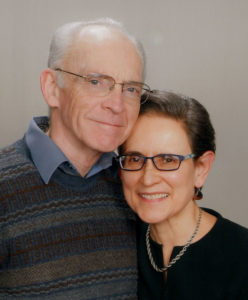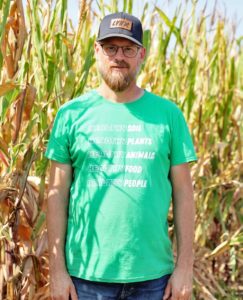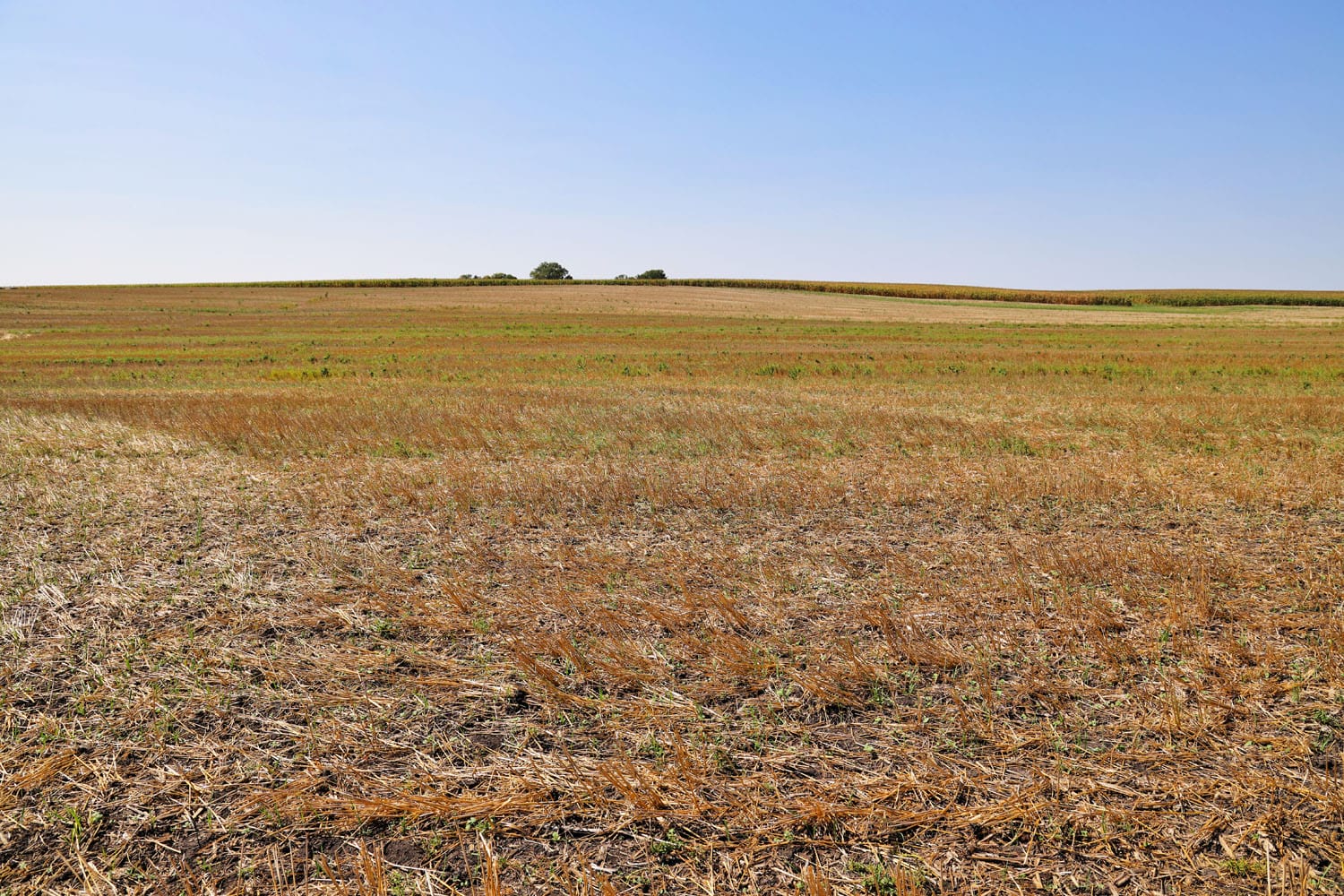Finding Common Ground
Open communication is central to how landowners Paul Thompson and Elena Meyer work with their farmland operator.
Paul Thompson grew up in the 1950s on a diversified farm near Belmond, in north-central Iowa, which his grandfather purchased in 1900. “We grew sugar beets, dairy cattle, pigs, chickens, honeybees, sheep, dogs, cats and seven people,” he says.
As a boy, Paul loved farming but was also drawn to architecture. After receiving a master’s in architecture and working on post-disaster housing in Latin America for three years, he eventually settled in Madison, Wisconsin. His career took him to over 50 countries where he trained humanitarian organizations in preparing for or responding to natural disasters, in managing refugee emergencies and in reconstructing after civil conflict.
Paul left the farm but kept ownership of the land he inherited from his family. He also bought the land his brother inherited, adding him to a growing number of landowners in Iowa and the U.S. who grew up on a farm but no longer operate it themselves.
Some of these landowners have minimal to no involvement with the land – and this can be especially true for those who live far away. For Paul, however, distance hasn’t dimmed his connection. He and his wife, Elena Meyer, are showing how farmland owners who have a vision for stewarding their land can partner with a farm operator who shares that vision.
Elena Meyer, a retired attorney, shares Paul’s enthusiasm for improving land stewardship through farm management. She lived near the family farm for several months, cares deeply about the Belmond community, and brings a tenants’ rights perspective to lease negotiations.
Changing Directions
Like most farms in Iowa, the farm tenants operating Paul’s land raised only corn and soybeans for decades. In 2019, after years of increasing concerns about soil health and conservation, Paul and Elena made the momentous decision to change tenants. They wanted to find a farm operator who would transition their land to a more sustainable model.
In particular, they wanted to find someone willing to add no-till, cover crops and a third crop into the rotation. Through a farm manager, they connected with Josh Nelson, a young farmer from Belmond who was looking for additional land to farm.
With his family, Josh raises rye, oats, corn, soybeans and a small herd of Scottish Highland cattle, along with some feeder pigs, at Cardinal Creek Farm. Since 2015, he’s also been planting no-till soybeans, strip-tilling corn and using cover crops.
“We interviewed him, talked through our mutual objectives and concluded our agreement (for him) to take over the farm in 2020,” Paul says. That year, Josh added Paul and Elena’s 197 acres to his production.
Their shared interest in soil health and regenerative practices is important. But Paul and Elena emphasize that trust and open communication are just as important to making the relationship work.
“Sometimes we guide Josh, sometimes he guides us,” Paul says. “Having a profound mutual respect has helped. Each year, Josh has been more willing to speak his mind and to let us pay him for the time he uses in improving the practices on the farm.”
The story of their partnership highlights the importance – and the rewards – of shared risk and collaboration between landowners and farm operators.
Adding Small Grains
Of Paul and Elena’s top farmland goals, integrating a third crop was a new challenge for Josh, but one he was willing to take on. He chose to try planting oats.
“They were concerned about fertilizer runoff and general soil health,” Josh says. “When you have that third crop, it gives the soil time to recover, time to breathe a bit and to plant a multispecies cover crop mix.”
After he harvests the oats mid-summer, he plants a multispecies cover crop – currently an eight- or nine-seed cover crop mix. While a single cover crop species is still good for the soil, Josh says that adding more plant families and root types supercharges the soil.
“You’re increasing the diversity in your microbes, and in the types of insects you attract,” he says. “You have to be careful how you design your mix, but if you get help, you’re going to see results the next year.”
The hardest part of adding a third crop, Josh says, was finding a market for the oats. He also had to adapt to receiving a lower gross profit than he had on corn and soybeans alone. But he says his net profit is better because he spends less money on seed and fertilizers and has fewer acres to harvest in the fall.
He also values how the benefits of the cover crop carry over to next season. “The net profit, and the amount of labor you save, makes it worth it,” Josh says. “And I’ve planted a full long-season cover crop after the oat harvest, which sets me up well for corn the following year. That’s been the real benefit.”
Aware of the challenges and risks associated with adding small grains into the rotation – including the financial risk – Paul and Elena offered Josh a significant rent discount on up to 30 acres of small-grain production. They saw it as a matter of fairness and as a way to encourage further exploration.
“We don’t want him taking risk without a mutually supportive arrangement,” Paul says.
“He can keep experimenting,” Elena adds. “But not at his expense.”
Designing a Fair Land Lease
Looking for other ways to promote fairness, Paul and Elena turned their attention to the terms of their lease with Josh. Using a flex lease based on the market price of corn and soybean yields didn’t make sense when oats were added into the equation.
When PFI launched its Landowner Coaching program in 2022, Paul and Elena signed up, curious to find ways to work small grains into a flex lease. The program gives any landowner who has at least 80 acres of row crops a chance to learn more about their land from a professional – in this case, Mollie Aronowitz, a farm manager and conservation agronomist with Peoples Company.
With Mollie, they discussed the potential for crop-share, where everyone shares the expenses and profits. Paul felt this approach was the fairest since it places an equal risk on all parties. “But we were in no position to market our own corn, soybeans and oats,” Paul says. “So the next best thing was a flex lease.”
With a flex lease, a landowner charges a low base rate, then calculates a final payment based on yields at harvest. Paul and Elena opted to structure theirs by negotiating a rate for the corn and bean yields, as well as a percentage of the total proceeds from all sources of income from all acres devoted to small grains.
Paul and Elena credit PFI’s Landowner Coaching program with helping them better understand rental options. But they also learned a lot about their farm.
As part of their meeting with Mollie, they received a detailed report that included topographic maps, corn suitability ratings, soil types, rainfall data and more. Mollie also shared resources and worksheets they could use to communicate about farm practices with their farm operator. “I can’t think of a section that wasn’t helpful to us,” Elena says.
Josh has also found the process – and his relationship with Paul and Elena – to be worthwhile. “I can’t believe how great they’ve been to work with,” he says. “They ask a lot, but that’s because they’re interested in their farm, and that’s a good thing. And, they’re not asking for something that’s overly burdensome.”
Elena sums up what makes their relationship so constructive: “Unless you have an honest, transparent relationship, you can’t really define fairness because each of you is wondering what the other is really saying. When you don’t need to decipher the negotiation, that is the only way you can know if each is really satisfied and comfortable, understanding what needs to be tweaked.”
As the trio continue their collaboration, this kind of honest communication will remain central to their shared vision of land stewardship.
CORRECTION: May 24, 2024 — In our print version of the magazine, we misidentified Paul in the second paragraph, referring erroneously to a different Paul Thompson who is an emeritus senior scientist in the Department of Biological Systems Engineering at University of Wisconsin-Madison.
The article also incorrectly referred to a single tenant farming Paul’s land instead of “tenants,” and stated that Paul and Elena’s flex lease preserved a discount for acres planted to small grains. The flex lease does not include that discount.
These errors have been corrected in this online version.
To learn more about PFI’s Landowner Coaching program, ways to improve landowner-tenant communication or to receive the Practical Landowner e-newsletter, contact martha.mcfarland(at)practicalfarmers(dot)org.



